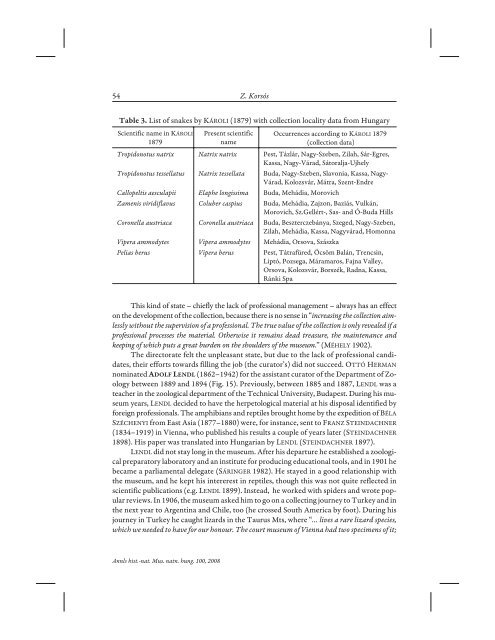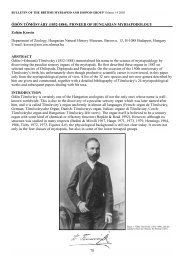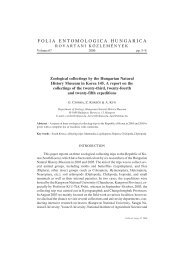History of the Herpetological Collection of the ... - Korsós Zoltán
History of the Herpetological Collection of the ... - Korsós Zoltán
History of the Herpetological Collection of the ... - Korsós Zoltán
Create successful ePaper yourself
Turn your PDF publications into a flip-book with our unique Google optimized e-Paper software.
54 Z. Korsós<br />
List <strong>of</strong> snakes by KÁROLI (1879) with collection locality data from Hungary<br />
Scientific name in KÁROLI<br />
1879<br />
Present scientific<br />
name<br />
Occurrences according to KÁROLI 1879<br />
(collection data)<br />
Tropidonotus natrix Natrix natrix Pest, Tázlár, Nagy-Szeben, Zilah, Sár-Egres,<br />
Kassa, Nagy-Várad, Sátoralja-Ujhely<br />
Tropidonotus tessellatus Natrix tessellata Buda, Nagy-Szeben, Slavonia, Kassa, Nagy-<br />
Várad, Kolozsvár, Mátra, Szent-Endre<br />
Callopeltis aesculapii Elaphe longissima Buda, Mehádia, Morovich<br />
Zamenis viridiflavus Coluber caspius Buda, Mehádia, Zajzon, Baziás, Vulkán,<br />
Morovich, Sz.Gellért-, Sas- and Ó-Buda Hills<br />
Coronella austriaca Coronella austriaca Buda, Beszterczebánya, Szeged, Nagy-Szeben,<br />
Zilah, Mehádia, Kassa, Nagyvárad, Homonna<br />
Vipera ammodytes Vipera ammodytes Mehádia, Orsova, Szászka<br />
Pelias berus Vipera berus Pest, Tátrafüred, Öcsöm Balán, Trencsin,<br />
Liptó, Pozsega, Máramaros, Fajna Valley,<br />
Orsova, Kolozsvár, Borszék, Radna, Kassa,<br />
Ránki Spa<br />
This kind <strong>of</strong> state – chiefly <strong>the</strong> lack <strong>of</strong> pr<strong>of</strong>essional management – always has an effect<br />
on <strong>the</strong> development <strong>of</strong> <strong>the</strong> collection, because <strong>the</strong>re is no sense in “increasing <strong>the</strong> collection aimlessly<br />
without <strong>the</strong> supervision <strong>of</strong> a pr<strong>of</strong>essional. The true value <strong>of</strong> <strong>the</strong> collection is only revealed if a<br />
pr<strong>of</strong>essional processes <strong>the</strong> material. O<strong>the</strong>rwise it remains dead treasure, <strong>the</strong> maintenance and<br />
keeping <strong>of</strong> which puts a great burden on <strong>the</strong> shoulders <strong>of</strong> <strong>the</strong> museum.”(MÉHELY 1902).<br />
The directorate felt <strong>the</strong> unpleasant state, but due to <strong>the</strong> lack <strong>of</strong> pr<strong>of</strong>essional candidates,<br />
<strong>the</strong>ir efforts towards filling <strong>the</strong> job (<strong>the</strong> curator’s) did not succeed. OTTÓ HERMAN<br />
nominated<br />
(1862–1942) for <strong>the</strong> assistant curator <strong>of</strong> <strong>the</strong> Department <strong>of</strong> Zoology<br />
between 1889 and 1894 (Fig. 15). Previously, between 1885 and 1887, LENDL was a<br />
teacher in <strong>the</strong> zoological department <strong>of</strong> <strong>the</strong> Technical University, Budapest. During his museum<br />
years, LENDL decided to have <strong>the</strong> herpetological material at his disposal identified by<br />
foreign pr<strong>of</strong>essionals. The amphibians and reptiles brought home by <strong>the</strong> expedition <strong>of</strong> BÉLA<br />
SZÉCHENYI from East Asia (1877–1880) were, for instance, sent to FRANZ STEINDACHNER<br />
(1834–1919) in Vienna, who published his results a couple <strong>of</strong> years later (STEINDACHNER<br />
1898). His paper was translated into Hungarian by LENDL (STEINDACHNER 1897).<br />
LENDL did not stay long in <strong>the</strong> museum. After his departure he established a zoological<br />
preparatory laboratory and an institute for producing educational tools, and in 1901 he<br />
became a parliamental delegate (SÁRINGER 1982). He stayed in a good relationship with<br />
<strong>the</strong> museum, and he kept his intererest in reptiles, though this was not quite reflected in<br />
scientific publications (e.g. LENDL 1899). Instead, he worked with spiders and wrote popular<br />
reviews. In 1906, <strong>the</strong> museum asked him to go on a collecting journey to Turkey and in<br />
<strong>the</strong> next year to Argentina and Chile, too (he crossed South America by foot). During his<br />
journey in Turkey he caught lizards in <strong>the</strong> Taurus Mts, where “… lives a rare lizard species,<br />
which we needed to have for our honour. The court museum <strong>of</strong> Vienna had two specimens <strong>of</strong> it;<br />
Annls hist.-nat. Mus. natn. hung. 100, 2008




